Chiribaya Dog
The Chiribaya Dog, or Chilean Terrier, is a small, intelligent breed known for its loyalty and adaptability. With a rich history in Chile, they excel as companions and vermin hunters.
Overview
🐕Breed Overview
✨Key Traits
💡What Makes Chiribaya Dog Special
The Chiribaya Dog is characterized by its adaptability, intelligence, and strong work ethic. They are known for their loyalty and affection towards their families, often forming close bonds with their owners.
Their history as vermin hunters has instilled in them a natural instinct to chase and hunt, making them energetic and playful companions. Chiribaya Dogs are also known for their cleanliness and low grooming needs, making them suitable for various living situations.
Their ability to adapt to both rural and urban environments showcases their versatility as a breed.
The Chiribaya Dog, also known as the Chilean Terrier or Ratonero, is a small yet tenacious breed that has captured the hearts of dog lovers in Chile and beyond. With a history dating back to the late 19th century, this breed was developed from a mix of European Fox Terriers and native Chilean dogs, resulting in a resilient and adaptable companion. Known for their intelligence and loyalty, Chiribaya Dogs excel in various roles, from vermin control to being affectionate family pets.
Their short, clean coat typically features a white base with black and brown markings, making them easily recognizable. Standing between 11 to 15 inches tall and weighing 9 to 17 pounds, they are well-suited for both rural and urban living environments. Chiribaya Dogs are known for their playful and affectionate nature, making them excellent companions for families and individuals alike.
They thrive on social interaction and enjoy being included in family activities. Their moderate exercise needs can be met through daily walks, play sessions, and engaging games that stimulate their hunting instincts. While they may be wary of strangers, their loyalty to their families is unwavering.
Training a Chiribaya Dog is a rewarding experience, as they are eager to learn and respond well to positive reinforcement. Early socialization is crucial to ensure they develop into well-rounded adults. With proper training and care, these dogs can adapt to various living situations, making them suitable for both city dwellers and those in rural areas.
In summary, the Chiribaya Dog is a unique breed with a rich history and a strong connection to Chilean culture. Their adaptability, intelligence, and affectionate nature make them a wonderful addition to any home, providing companionship and joy to their owners.
🎉Fun Facts
Chiribaya Dogs are highly adaptable and can thrive in both urban and rural settings.
Chiribaya Dogs are known for their exceptional vermin-hunting skills, making them popular among farmers.
The breed is featured in Chilean popular culture, particularly through the character Washington from the comic 'Condorito.'
They have a strong bond with their families and often follow their owners around the house.
Breed Characteristics
Family & Friends
Good Behavior
Get Up & Go
Household Harmony
Temperament & Personality
✨Key Traits
🐕Core Temperament
Chiribaya Dogs are generally friendly and affectionate, displaying a playful and energetic demeanor. They are known for their loyalty and protective instincts, making them excellent companions and watchdogs.
While they may be cautious around strangers, their socialization can help them become more comfortable in various situations. Their tenacity and intelligence contribute to their ability to learn quickly, but they require consistent training to channel their energy positively.
💫Personality Profile
Chiribaya Dogs are known for their lively and affectionate nature. They are intelligent and eager to please, making them relatively easy to train.
Their playful demeanor often shines through during playtime, and they enjoy engaging with their families. While they can be wary of strangers, their loyalty to their owners is unwavering.
These dogs thrive on social interaction and are happiest when included in family activities. Their tenacity and strong prey drive make them excellent hunters, but they also require proper training to manage these instincts effectively.
🔊Vocal Tendencies
Chiribaya Dogs have a moderate noise level, often barking to alert their owners of strangers or unusual sounds. They may also bark during play or when excited.
While they are not excessive barkers, their vocalizations can be managed through proper training and socialization. Understanding their barking tendencies is essential for owners, especially in urban settings where noise may be a concern.
Affection & Social Traits
Energy & Activity
Communication Style
Care Requirements
🏃♂️Exercise Requirements
Daily Exercise
The Chiribaya Dog, also known as the Chilean Terrier, requires moderate exercise to maintain its health and happiness. Ideally, this breed should engage in at least 30 to 60 minutes of physical activity each day. This can include brisk walks, play sessions in the yard, or interactive games that stimulate their hunting instincts.
Activities like fetch or agility training can be particularly beneficial, as they not only provide physical exercise but also mental stimulation. For puppies, shorter play sessions of about 15-20 minutes are recommended, gradually increasing as they grow. Adult Chiribaya Dogs thrive on routine and enjoy being included in family activities, making them excellent companions for active households.
Insufficient exercise can lead to behavioral issues such as excessive barking or destructive tendencies, as these dogs are naturally energetic and inquisitive. Regular exercise contributes positively to their physical health, weight management, and overall well-being, ensuring they remain happy and well-adjusted companions.
Preferred Activities
🏠Living & Adaptability
Space Requirements
Chiribaya Dogs are adaptable and can thrive in various living environments, from apartments to homes with yards. However, they do best in settings where they have access to outdoor space for exercise and play.
A small yard or nearby park is sufficient, as long as they receive regular walks and mental stimulation. In urban settings, it's essential to provide daily opportunities for exercise and socialization to prevent boredom and anxiety.
Their small size allows them to adjust well to indoor living, but they should not be confined for long periods, as they are social animals that enjoy being part of family activities.
Climate Preference
🍲Feeding Guide
Schedule
Food Types
Portion Size
Special Nutritional Needs
Chiribaya Dogs do not have specific dietary restrictions, but it is essential to provide a balanced diet rich in protein and essential nutrients to support their active lifestyle. Regular veterinary check-ups can help identify any food sensitivities or allergies.
✨Grooming Requirements
Grooming Overview
The Chiribaya Dog has a short, clean coat that requires minimal grooming. Regular brushing once a week is sufficient to remove loose hair and keep the coat healthy.
Bathing should be done as needed, typically every few months or when they become dirty. Regular nail trimming and dental care are also important to maintain overall health.
Their ears should be checked regularly for dirt and wax buildup, and cleaned as necessary to prevent infections.
Care Schedule
Brush weekly, bathe as needed (every few months), trim nails every 2-4 weeks.
Health Profile
⚕️Health Care
Regular veterinary care is crucial for maintaining the health and longevity of Chiribaya Dogs. Routine check-ups, vaccinations, and preventive treatments can help catch potential health issues early. Owners should also be proactive in managing their dog's weight and providing a balanced diet to support overall health throughout their life stages.
Health Issues Overview
⏳Average Lifespan
Genetic Factors
Genetics play a significant role in the Chiribaya Dog's lifespan, with certain hereditary health issues being more prevalent in the breed. Responsible breeding practices that prioritize genetic diversity can help mitigate these risks. Potential owners should seek reputable breeders who conduct health screenings to ensure the best possible genetic health for their puppies.
Living Conditions
Chiribaya Dogs thrive in environments that provide ample opportunities for exercise and social interaction. Urban settings with access to parks or open spaces are ideal, as they enjoy being active and engaged with their owners.
Rural environments also suit them well, allowing them to utilize their hunting instincts. A stable and loving home environment contributes positively to their lifespan, as stress and neglect can lead to health issues.
🏥Common Health Issues
Hip Dysplasia
Warning Signs
🔬Diagnosis
X-rays and physical examinations by a veterinarian.
💊Treatment
Medications, weight management, and in severe cases, surgery.
📝Management Tips
Maintain a healthy weight, provide joint supplements, and ensure regular exercise to support joint health.
Dental Issues
Warning Signs
🔬Diagnosis
Veterinary dental examinations.
💊Treatment
Dental cleanings, extractions if necessary.
📝Management Tips
Regular dental care, including brushing and professional cleanings, can help prevent dental diseases.
🛡️Preventive Care
🔬Hip Evaluation
Hip Evaluation assesses the hip joints for dysplasia and other abnormalities, crucial for maintaining joint health in active dogs.
📅 Annually after 1 year of age.
🔬Dental Examination
Dental Examination checks for periodontal disease and other dental issues, important for overall health and well-being.
📅 Every 6 months.
Training
🧠Intelligence & Trainability
💪Work Drive
Chiribaya Dogs possess a strong work drive, stemming from their history as hunters and vermin controllers. They thrive when given tasks to complete, whether it's participating in agility training, engaging in scent work, or simply accompanying their owners on outdoor adventures.
This need for mental and physical engagement is essential for their well-being. Without sufficient stimulation, they may become bored and exhibit destructive behaviors.
Owners should aim to incorporate a variety of activities into their daily routine to keep their Chiribaya Dogs happy and fulfilled.
⚠️Training Considerations
Chiribaya Dogs may exhibit some behavioral challenges, particularly if not properly socialized. They can be wary of strangers and may bark excessively if they feel threatened.
Additionally, their strong prey drive can lead them to chase small animals if not trained appropriately. To overcome these challenges, early socialization is crucial.
Exposing them to various environments, people, and other animals from a young age can help mitigate fearfulness and promote confidence. Consistent training using positive reinforcement methods will also aid in managing barking and ensuring they respond well to commands.
📝Training Tips
Training a Chiribaya Dog can be a rewarding experience, as they are intelligent and eager to please. Utilizing positive reinforcement techniques, such as treats and praise, will encourage good behavior.
Short, engaging training sessions are ideal, as these dogs can become bored with lengthy routines. Incorporating play into training can also enhance their learning experience.
Consistency is key; establishing clear commands and routines will help them understand expectations. Additionally, providing mental stimulation through puzzle toys or interactive games can keep their minds sharp and reduce unwanted behaviors.
History & Heritage
📜Origin Story
The Chiribaya Dog, or Chilean Terrier, has a rich history that intertwines with the arrival of European settlers in South America. Brought to Chile by immigrants, these dogs were initially used for hunting small game and controlling rodent populations.
Over the years, they adapted to the local environment, developing a robust and resilient character. The breed's name, 'Chiribaya,' reflects its roots in the cultural tapestry of Chile, where it has been a beloved companion and working dog for generations.
The breed's journey from rural farms to urban homes illustrates its adaptability and enduring appeal among Chileans.
⏳Development History
The Chiribaya Dog's development can be traced back to the late 19th century, originating from a mix of European Fox Terriers and native Chilean dogs. This breed was cultivated for its hunting abilities, particularly in controlling vermin populations on farms.
Over time, the breed adapted to various environments, from rural estates to urban areas, showcasing its versatility. Despite facing challenges in recognition and popularity, efforts by organizations like ACEPE have aimed to promote and preserve the breed, leading to its inclusion in various kennel clubs and exhibitions.
🛡️Purpose & Historical Role
Originally bred for vermin control, the Chiribaya Dog has served as a loyal companion and protector throughout its history. Its role has evolved from a working dog on farms to a cherished family pet in urban settings. The breed's tenacity and intelligence make it an excellent watchdog, while its affectionate nature ensures it remains a beloved member of the family.
🏺Cultural Significance
The Chiribaya Dog holds a special place in Chilean culture, symbolizing the resilience and adaptability of the Chilean people. Historically, these dogs were companions to farmers and rural workers, serving as effective vermin hunters in both rural estates and urban settings.
Their presence in popular culture is notable, particularly through the character Washington from the comic 'Condorito,' which has endeared the breed to many Chileans. This breed represents a blend of European and native influences, showcasing the rich history of dog breeding in Chile.
Conservation Status
This breed is well-established with healthy population numbers.









